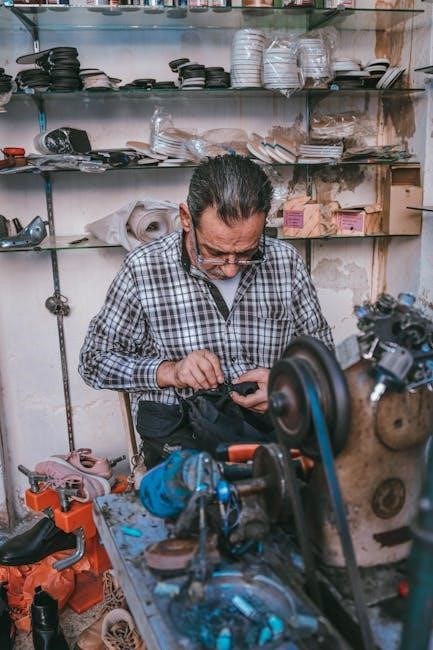
The Kenmore Sewing Machine 158 is a versatile, user-friendly appliance designed for both beginners and experienced sewists, offering durability, wide stitching options, and suitability for various fabrics and projects.
Overview of the Kenmore Sewing Machine 158
The Kenmore Sewing Machine 158 is a dependable, versatile sewing machine designed for a wide range of projects, from basic repairs to intricate creations. Known for its durability and ease of use, it features multiple stitch options, including straight and zigzag stitching, making it suitable for various fabrics like cotton, denim, and silk. Its compact design and user-friendly interface cater to both beginners and experienced sewists. The machine’s robust construction ensures consistent performance, while its compatibility with optional accessories enhances its functionality for specialized tasks such as quilting or embroidery.
Importance of the Manual for Optimal Performance
The manual for the Kenmore Sewing Machine 158 is essential for unlocking its full potential. It provides step-by-step instructions for setup, operation, and maintenance, ensuring users can maximize performance. Detailed troubleshooting guides help resolve common issues like skipped stitches or thread breaks. The manual also covers advanced features such as programmable stitch sequences and buttonhole settings. By following the manual, users can maintain their machine’s efficiency, extend its lifespan, and achieve professional-quality results. It serves as a comprehensive guide for both novices and experienced sewists, helping them navigate the machine’s capabilities with confidence and precision.

Getting Started with the Kenmore Sewing Machine 158
Unboxing and setting up your Kenmore 158 involves threading, winding the bobbin, and attaching the presser foot. Follow the manual for smooth operation and optimal results.
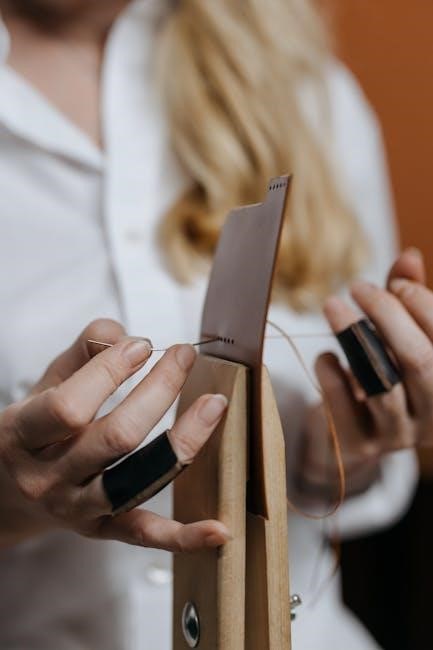
Unboxing and Initial Setup
Unboxing your Kenmore Sewing Machine 158 is an exciting first step. Carefully remove the machine from its packaging and inspect for any damage. Included are the sewing machine, power pedal, and user manual. Place the machine on a stable, flat surface and ensure good lighting. Before use, read the manual to understand the machine’s components and safety guidelines. Familiarize yourself with the control panel, presser feet, and bobbin area. Plug in the machine and test basic functions to ensure proper operation. This setup process ensures a smooth start to your sewing journey.
Basic Safety Precautions
Always prioritize safety when using the Kenmore Sewing Machine 158. Ensure the machine is placed on a stable, flat surface and keep loose clothing or long hair tied back. Avoid touching moving parts, especially the needle, and never sew near children or pets. Keep fingers away from the needle and presser foot during operation. Unplug the machine before cleaning or performing maintenance. Use the power pedal carefully to avoid sudden starts. Store sharp tools like needles and scissors safely. Regularly inspect the cord for damage and avoid overloading electrical outlets. Following these precautions ensures a safe and enjoyable sewing experience.
Threading the Machine and Winding the Bobbin
Properly threading the Kenmore Sewing Machine 158 is essential for smooth operation. Begin by guiding the thread through the tension discs, ensuring it clicks into place. Then, pass the thread through the take-up lever and down to the needle. For the bobbin, place the thread on the bobbin pin and wind it evenly, cutting the excess. Insert the bobbin into the bobbin case, ensuring it spins correctly. Always refer to the manual for specific threading paths and tension adjustments. Proper threading ensures consistent stitching and prevents issues like uneven tension or thread breakage during sewing.
Attaching the Presser Foot and Inserting the Needle
To attach the presser foot, align the foot with the shank and snap it into place until it clicks securely. Ensure the foot is compatible with your project type, such as the zigzag or zipper foot. For inserting the needle, grasp it firmly and slide it into the needle bar, ensuring it aligns with the mark on the bar. Gently push until it clicks into position. Always handle the needle carefully to avoid bending it. After installation, pull gently on the needle to confirm it is securely seated. Proper installation ensures smooth stitching and prevents machine misalignment.
Adjusting Thread Tension for Proper Stitching
Proper thread tension is crucial for even stitching on the Kenmore Sewing Machine 158. Start by threading the machine as instructed in the manual. Locate the small dials on the front or side of the machine, which control the upper and lower thread tension. Turn the dials to increase or decrease tension, testing on scrap fabric to ensure balanced stitches. If the thread is too tight, stitches may pucker; if too loose, they may unravel. Adjust in small increments, checking results each time. For specific fabric types or stitch patterns, consult the manual for recommended tension settings to achieve optimal results.
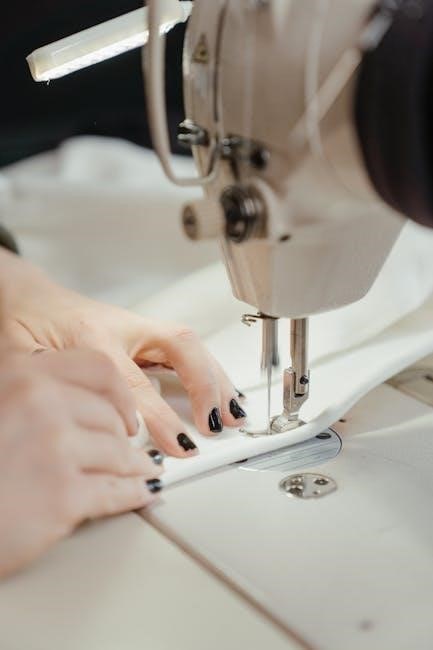
Understanding the Control Panel and Stitch Settings
The control panel of the Kenmore Sewing Machine 158 features intuitive buttons for selecting stitch patterns, adjusting stitch length and width, and accessing advanced settings like speed control and automatic threading.
Selecting Stitch Patterns and Adjusting Stitch Length/Width
The Kenmore Sewing Machine 158 offers a variety of stitch patterns, including straight, zigzag, and decorative options, to suit different sewing projects. Users can easily select their desired stitch pattern using the control panel. Adjusting stitch length and width is straightforward, allowing for customization based on fabric type and sewing technique. Proper adjustment ensures even stitching and prevents fabric damage. The machine’s manual provides clear guidance on optimizing these settings for various materials, from delicate silk to heavy denim, ensuring professional-quality results; This feature enhances creativity and versatility for both beginners and experienced sewists.
Using Speed Controls for Precision Sewing
The Kenmore Sewing Machine 158 features speed control settings, allowing users to adjust sewing speed for precise stitching. This feature is especially useful for intricate patterns, delicate fabrics, or thick materials. By slowing down, sewists can maintain accuracy, while faster speeds are ideal for straight seams. The control panel provides easy access to speed adjustments, ensuring optimal performance for various projects. Proper use of speed controls enhances stitching quality and prevents errors. The manual offers tips for mastering speed settings, helping users achieve professional results across different sewing tasks. This feature is a key asset for both beginners and experienced sewists.
Advanced Features: Automatic Threading and Buttonhole Settings
The Kenmore Sewing Machine 158 offers advanced features like automatic threading, simplifying the setup process and saving time. This feature reduces eye strain and ensures proper thread alignment. Additionally, the machine includes multiple buttonhole settings, allowing users to create custom buttonholes with ease. Perfect for garments and home decor, these settings provide precise results. The manual details how to use these features, enabling sewists to explore creative possibilities. These advanced functions make the Kenmore 158 ideal for both simple and complex sewing projects, ensuring efficiency and professional-quality outcomes;
Programmable Stitch Sequences for Custom Projects
The Kenmore Sewing Machine 158 allows users to program custom stitch sequences, enabling personalized patterns for unique projects. This feature is ideal for quilters, embroiderers, and crafters seeking precision and creativity. The machine permits saving favorite stitch combinations, ensuring quick access for repeated use. Adjustments for stitch length, width, and order can be made effortlessly, offering tailored results. The manual provides clear guidance on accessing and editing programmable sequences, making it easy to achieve professional-quality, one-of-a-kind designs. This feature enhances versatility, catering to diverse sewing needs and creative ambitions.
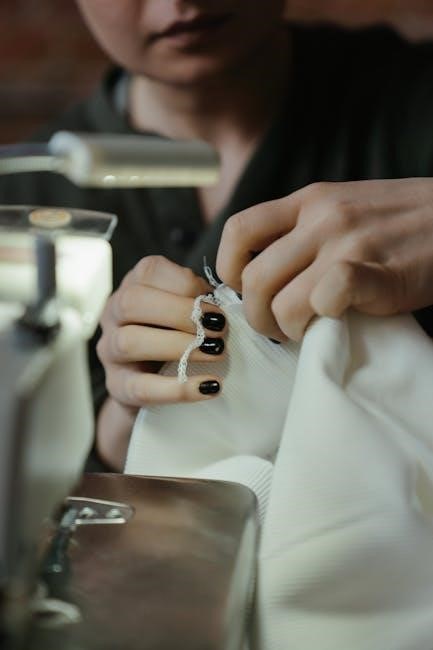
Sewing Techniques and Fabric Compatibility
The Kenmore Sewing Machine 158 supports various techniques like straight stitching, zigzag, and decorative embroidery, ensuring compatibility with fabrics such as denim, silk, and more for professional results.
Mastering Straight Stitching and Zigzag Stitching
The Kenmore Sewing Machine 158 excels in basic yet essential stitches, starting with the straight stitch, perfect for general sewing and repairs.
Adjust the stitch length for heavier fabrics like denim or canvas.
For zigzag stitching, ideal for stretchy fabrics, the machine offers precise control over width and length.
This stitch prevents fraying and is great for finishing seams.
Use the manual’s guidance to master these foundational techniques, ensuring professional results for all your projects.
With practice, you’ll achieve smooth, consistent stitching every time, making these stitches indispensable for any sewing task.
Sewing Hems, Seams, and Buttonholes
The Kenmore Sewing Machine 158 simplifies sewing hems, seams, and buttonholes with its versatile stitch options and accessories.
For hems, use the blind hem stitch for invisible results or the straight stitch for a classic look.
Achieve precise seams with the all-purpose foot, while the walking foot handles thick fabrics effortlessly.
Buttonholes are made easy with the one-step automatic feature, ensuring perfect sizing and alignment.
The manual provides step-by-step guidance for these essential techniques, helping you create professional finishes on garments, home decor, and crafts.
With the Kenmore 158, every project is completed with precision and style.
Working with Specialty Fabrics: Denim, Silk, and More
The Kenmore Sewing Machine 158 excels with specialty fabrics, offering tailored settings for denim, silk, and more.
For heavy fabrics like denim, use the heavy-duty needle and adjust stitch length for even penetration.
Delicate fabrics such as silk benefit from a lighter touch, with a sharp needle and reduced presser foot pressure.
The machine also handles vinyl, leather, and stretchy knits with ease when paired with the right accessories, like the zipper foot or walking foot.
The manual provides fabric-specific tips to ensure optimal results for every project.
Decorative Embroidery and Quilting Techniques
The Kenmore Sewing Machine 158 is ideal for decorative embroidery and quilting, offering built-in embroidery designs and customizable stitch patterns.
Free-motion quilting allows for intricate details, while the quilting guide ensures precise, even stitching.
The machine supports layering fabrics and batting with ease, making it perfect for quilting projects.
For embroidery, users can adjust thread colors and densities to create vibrant, professional-looking designs.
The manual provides tips for selecting the right needles, threads, and tensions to achieve flawless results.
With these features, the Kenmore 158 brings creativity and precision to every embroidery and quilting project.
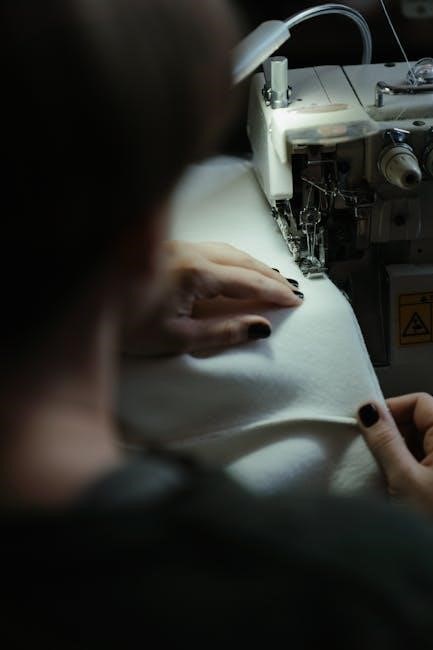
Machine Maintenance and Care
Regular maintenance ensures optimal performance. Clean the machine by removing lint and debris, oil moving parts for smooth operation, and inspect the needle and bobbin area. Store the machine in a dry place when not in use to prevent rust and damage. Follow the manual’s guidelines for proper care to extend the machine’s lifespan and maintain its efficiency.
Cleaning the Machine: Removing Lint and Debris
Cleaning your Kenmore Sewing Machine 158 is essential for maintaining its performance. Start by turning off and unplugging the machine. Remove the top cover and bobbin case to access internal parts. Use a soft brush or compressed air to gently remove lint and debris from the bobbin area, feed dogs, and stitch plate. Avoid using liquids to prevent damage. Regularly cleaning prevents dust buildup and ensures smooth stitching. Always refer to the manual for specific cleaning instructions to avoid damaging sensitive components. Clean after each use for optimal results.
Oiling the Machine for Smooth Operation
Regular oiling is crucial for maintaining the Kenmore Sewing Machine 158’s smooth operation. Turn off and unplug the machine before oiling. Locate the oil ports, typically found near the bobbin area or hook race. Use high-quality sewing machine oil, applying a few drops to the specified points. Gently turn the handwheel to distribute the oil evenly. Avoid over-oiling, as excess can attract dust. Consult the manual for exact oiling points and frequency. Proper lubrication ensures silent running, prevents friction, and extends the machine’s lifespan. Oil after cleaning or every 50 hours of use for optimal performance.
Inspecting and Replacing the Needle
Regular inspection of the needle is essential for maintaining the Kenmore Sewing Machine 158’s performance. Turn off and unplug the machine before inspecting. Remove the presser foot and inspect the needle for signs of wear, such as bending, dullness, or burrs. If damaged, replace the needle immediately. To replace, loosen the needle screw with a screwdriver, remove the old needle, and insert the new one, ensuring it aligns correctly. Tighten the screw firmly. Always use the correct needle type for your fabric. Replace the needle every 8 hours of use or when stitching quality decreases. Refer to the manual for specific guidance.
Storing the Machine When Not in Use
Proper storage ensures the longevity of your Kenmore Sewing Machine 158. Always clean the machine thoroughly, removing lint and debris from the bobbin area and feed dogs. Lightly oil moving parts to prevent rust. Disconnect the power cord and foot pedal for safety. Store the machine in a dry, cool place, away from direct sunlight and moisture. Use the provided cover or a breathable cloth to protect it from dust. Avoid storing it in extreme temperatures or humid environments. Regular maintenance before storage ensures the machine remains in optimal condition for future use.
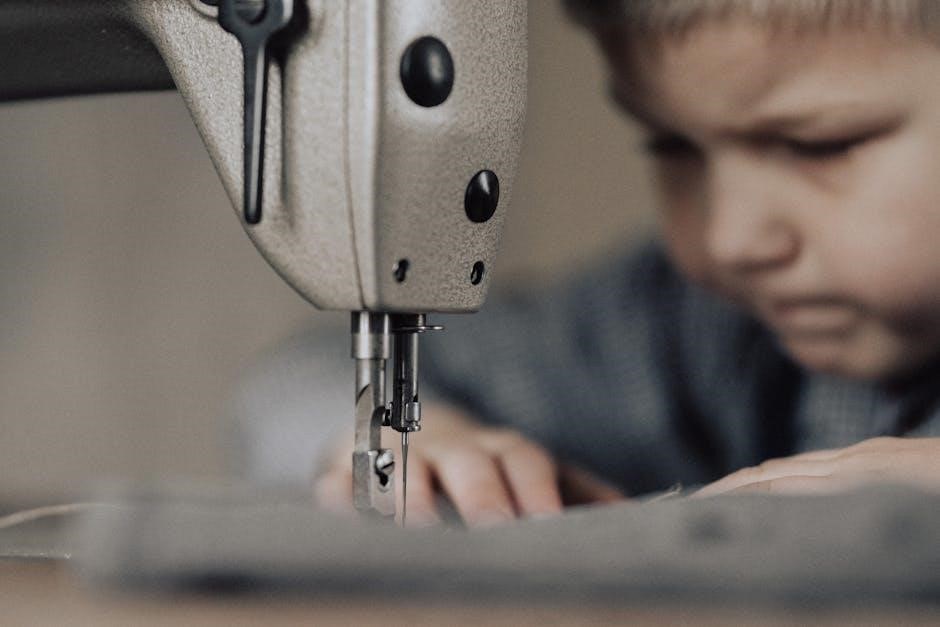
Troubleshooting Common Issues
Skipped stitches, broken threads, and bobbin jams are common issues. Check thread tension, clean lint, and ensure proper needle alignment. Regular maintenance prevents most problems.
Skipped Stitches: Causes and Solutions
Skipped stitches occur due to improper needle alignment, incorrect thread tension, or lint buildup. Ensure the needle is correctly inserted and rotated properly. Check thread tension and adjust if necessary. Clean the machine regularly to remove lint and debris. Use the appropriate needle type for your fabric. If issues persist, consult the manual for troubleshooting steps or consider professional maintenance to restore smooth stitching performance.
Broken Threads: Identifying and Fixing the Problem
Broken threads often result from improper thread tension, incorrect needle size, or lint buildup. Check thread tension and adjust to ensure it’s not too tight. Use a needle suitable for your fabric type and ensure it’s inserted correctly. Regularly clean the machine to remove lint and debris, which can cause thread friction. If threads continue to break, inspect for damaged or worn-out parts like the needle plate or bobbin case. Rethread the machine carefully, following the manual’s guidelines, and test on scrap fabric before resuming your project.
Bobbin Jams: Prevention and Resolution
Bobbin jams occur when thread tangles or debris accumulates in the bobbin case. To prevent this, always use the correct bobbin size and ensure it’s properly seated. Regularly clean the bobbin area and feed dogs to remove lint. If a jam occurs, turn off the machine, unplug it, and gently remove the bobbin case. Carefully cut and remove tangled thread, then rethread the machine following the manual’s instructions. Reinstall the bobbin and test on scrap fabric to ensure smooth operation. Proper maintenance and threading techniques can significantly reduce the risk of bobbin jams.
Interpreting Error Codes (if applicable)
The Kenmore Sewing Machine 158 may display error codes to indicate specific issues. These codes, often found in the manual, help diagnose problems like thread jams, bobbin errors, or sensor malfunctions. If an error code appears, refer to the manual’s troubleshooting section for explanations and solutions. Common codes include alerts for improper threading or bobbin installation. Resetting the machine or clearing jams usually resolves these issues. For persistent problems, contact Kenmore customer support or visit an authorized service center for professional assistance. Regular maintenance can help prevent errors and ensure smooth operation.
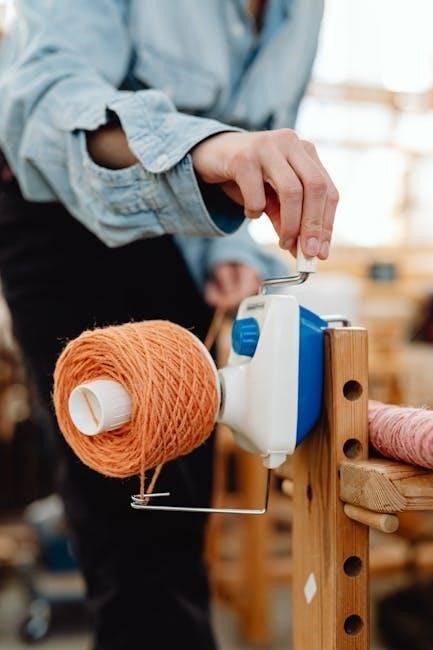
Advanced Features and Accessories
The Kenmore Sewing Machine 158 offers advanced features like automatic threading, buttonhole settings, and programmable stitch sequences. Accessories include a zipper foot, walking foot, and quilting guide for enhanced creativity and precision in various projects.
Using the Zipper Foot and Walking Foot
The Kenmore Sewing Machine 158 comes with a zipper foot and walking foot to enhance sewing versatility. The zipper foot is ideal for sewing zippers, piping, and thick fabrics, allowing precise control. The walking foot is designed for heavy-duty fabrics, quilting, and multiple layers, preventing fabric bunching. To attach, align the foot with the shank, secure it with the lever or screw, and ensure it’s tightly fastened. Use the zipper foot for accurate zipper alignment and the walking foot for smooth, even stitching on challenging materials, ensuring professional results for any project.
Installing and Using the Quilting Guide
The quilting guide is a valuable accessory for the Kenmore Sewing Machine 158, designed to help sew straight lines and maintain even spacing. To install, attach the guide to the machine’s shank or presser foot, ensuring it aligns with the edge of your fabric. Use it for quilting, sewing hems, or creating consistent seams. For best results, adjust the guide’s position based on your project’s needs. This tool is especially helpful for large quilting projects, providing precision and consistency. Refer to the manual for specific installation steps and tips on optimizing its use for various fabrics and patterns.
Free-Motion Quilting and Built-in Embroidery Designs
The Kenmore Sewing Machine 158 supports free-motion quilting, allowing for creative stitching without feed dog restrictions. Lower the feed dogs, attach the appropriate foot, and manually guide the fabric for intricate designs. Adjust the stitch length and tension for smooth, even quilting. For embroidery, the machine offers built-in designs, perfect for decorative touches. Use stabilizing material like interfacing to ensure crisp results. The manual provides step-by-step guidance for selecting and customizing embroidery patterns, making it easy to enhance your projects with professional-looking designs.
Connecting to Software for Custom Patterns
The Kenmore Sewing Machine 158 allows seamless connectivity to compatible software, enabling users to import and customize embroidery and quilting designs. Using a USB cable, you can transfer patterns from your computer to the machine. The manual provides step-by-step instructions for installing drivers, connecting the machine, and syncing designs. This feature is ideal for creating personalized projects, from intricate embroidery to complex quilting motifs. With the ability to edit and combine patterns, you can unlock endless creative possibilities, making your sewing projects truly unique and professional-looking.
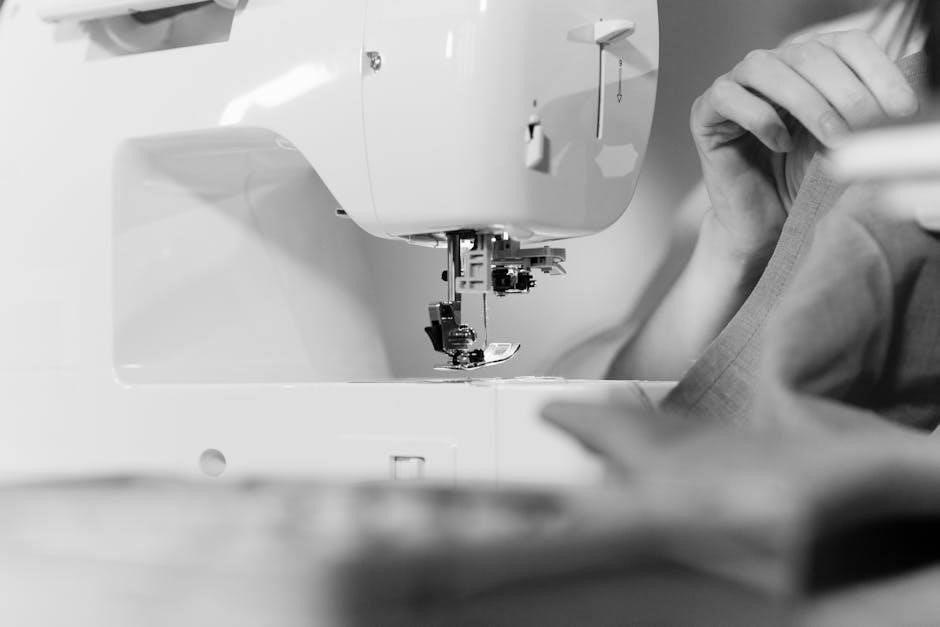
Energy Efficiency and Eco-Friendly Tips
Maximize energy savings by turning off the machine when idle, using LED lights, and avoiding unnecessary foot pedal pressure. Activate energy-saving modes for eco-friendly sewing.
Turning Off the Machine When Not in Use
Turning off the Kenmore Sewing Machine 158 when not in use is a simple yet effective way to conserve energy and reduce electricity costs. Always unplug the machine or switch off the power source to ensure no standby power is consumed. This practice also helps prolong the lifespan of the machine by preventing unnecessary wear on internal components. For added efficiency, consider using a power strip to easily manage the machine’s power supply. Regularly adopting this habit promotes eco-friendly sewing and supports energy-saving goals.
Using LED Lights for Energy Savings
The Kenmore Sewing Machine 158 features LED lights that contribute to energy efficiency by providing bright illumination while consuming minimal power. These lights are designed to last longer and use less energy compared to traditional bulbs, making them an eco-friendly choice. To maximize energy savings, ensure the LED lights are only used when necessary and consider adjusting their brightness if possible. Regularly cleaning the light covers can also enhance their efficiency. By utilizing LED lights, you not only reduce energy consumption but also contribute to a more sustainable sewing practice.
Avoiding Unnecessary Foot Pedal Pressure
Avoiding unnecessary foot pedal pressure is essential for efficient and energy-conscious sewing with the Kenmore Sewing Machine 158. Excessive pressure can strain the motor and increase energy consumption. Use a steady, gentle touch to maintain consistent stitching speed. Avoid pressing the pedal to its maximum unless required for heavy fabrics. This practice not only reduces wear on the machine but also helps lower overall energy usage. By applying moderate pressure, you can achieve smooth operation while preserving the longevity of your sewing machine and minimizing its environmental impact.
Activating Energy-Saving Modes
Activating energy-saving modes on the Kenmore Sewing Machine 158 is a straightforward process that helps reduce power consumption. Start by ensuring the machine is turned off. Locate the ‘Energy Saver’ or ‘Eco Mode’ button on the control panel, typically marked with an energy-efficient icon. Press and hold this button for a few seconds until the LED indicator lights up, confirming the mode is active.
Once activated, the machine will automatically adjust settings like brightness and standby timers. For models with smart features, energy-saving modes can also be accessed via the menu settings. Always refer to the manual for specific instructions tailored to your machine model to ensure optimal energy efficiency;

Warranty and Customer Support
The Kenmore Sewing Machine 158 comes with a comprehensive warranty, ensuring parts and repairs coverage. Customer support is accessible via phone, email, or authorized service centers.
Understanding the Warranty Coverage
The Kenmore Sewing Machine 158 is backed by a comprehensive warranty that covers parts and repairs for a specified period. The warranty ensures protection against manufacturing defects, providing peace of mind for users. Coverage typically includes mechanical components and electrical systems, while excluding normal wear and tear or misuse. To file a claim, users must register their machine and provide proof of purchase. The manual outlines step-by-step procedures for submitting claims and accessing support. This ensures quick resolution of issues, maintaining your machine’s performance and longevity.
Filing a Warranty Claim: Step-by-Step Guide
To file a warranty claim for the Kenmore Sewing Machine 158, start by reviewing the manual to confirm coverage details. Gather required documents, including the proof of purchase and warranty certificate. Contact Kenmore customer support via phone or email to initiate the process. Provide the machine’s model number and a detailed description of the issue. Follow the representative’s instructions to submit the claim, which may include uploading documents online. Once approved, arrange for repairs or replacements as directed. Regularly follow up to track the progress of your claim to ensure timely resolution.
Contact Information for Customer Support
For assistance with the Kenmore Sewing Machine 158, contact customer support through multiple channels. Visit the official Sears Parts Direct website at searspartsdirect.com for parts, manuals, and repair guidance. Call the dedicated support hotline at 1-800-326-8738 for troubleshooting or warranty inquiries. Additionally, email inquiries can be sent through the website’s contact form. Support is available Monday through Friday, 8 AM to 8 PM EST. For urgent issues, live chat is also available on select platforms. Ensure to have your machine’s model number and serial number ready for efficient assistance.
Authorized Service Centers and Online Resources
For professional maintenance or repairs, locate authorized Kenmore service centers through the Sears Parts Direct website. They offer certified technicians and genuine parts for the Kenmore Sewing Machine 158. Additionally, online resources like ManualsLib and Sewing-Parts.com provide access to manuals, diagrams, and repair guides. For peer support, join sewing communities on platforms like PatternReview or dedicated Facebook groups. These resources ensure comprehensive support for your sewing machine needs.
The Kenmore Sewing Machine 158 empowers sewists to unlock creativity and achieve professional results. With its robust features and comprehensive manual, it ensures reliable performance for every project.
Maximizing Creativity and Performance with the Kenmore 158
The Kenmore Sewing Machine 158 is designed to unlock your full creative potential while delivering exceptional performance. With its advanced features, including programmable stitch sequences and built-in embroidery designs, this machine offers unparalleled versatility. The comprehensive manual provides detailed guidance for mastering various techniques, from straight stitching to decorative embroidery, ensuring you achieve professional-quality results. Whether you’re working with delicate fabrics or heavy-duty materials, the Kenmore 158 adapts seamlessly, offering precise control and consistency. By leveraging its intuitive interface and customizable settings, you can bring your most ambitious sewing projects to life with ease and confidence.
Final Tips for Getting the Most Out of Your Sewing Machine
To maximize your sewing experience with the Kenmore 158, regularly maintain the machine by cleaning and oiling it, and always use the appropriate needles and threads for your projects. Experiment with different stitch patterns and fabric types to explore its full potential. Keep the user manual handy for quick reference, and take advantage of its troubleshooting guide to resolve any issues promptly. By following these tips, you’ll ensure optimal performance, extend the machine’s lifespan, and achieve professional-quality results in all your sewing endeavors.